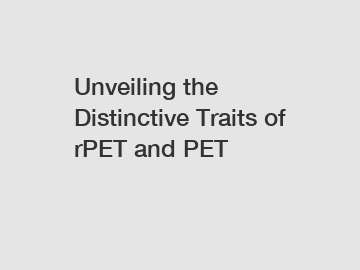Unveiling the Distinctive Traits of rPET and PET
Unveiling the Distinctive Traits of rPET and PET.
As consumers become more conscious about the environment, the demand for sustainable packaging solutions has significantly increased in recent years. Among the various options available, two commonly used materials are rPET (recycled polyethylene terephthalate) and PET (polyethylene terephthalate). While they may seem similar at first glance, it is essential to understand their distinctive traits to make informed decisions about their usage. In this article, we will delve into the characteristics of both rPET and PET, highlighting their differences and similarities.
rPET: The Sustainable Alternative.

rPET is a material that is obtained by recycling used PET containers. This process involves sorting and cleaning the discarded PET bottles, followed by shredding and converting them into small flakes. These flakes are then melted and spun into yarn or molded into plastic products. The use of rPET has numerous environmental benefits, including a significant reduction in carbon emissions, energy consumption, and dependence on fossil fuels.
1. Environmental Impact:
rPET is widely regarded as a sustainable alternative to PET due to its reduced environmental impact. The production of rPET requires fewer resources, as it relies on recycling existing PET materials rather than manufacturing new ones from scratch. This not only conserves energy but also reduces the amount of waste sent to landfills or incinerators.
2. Strength and Durability:
One of the misconceptions about rPET is that it is of inferior quality compared to PET. However, advanced recycling technologies have made significant progress in improving the strength and durability of rPET materials. These recycled materials can now meet the same performance standards as their virgin counterparts, ensuring that products made from rPET can withstand various stresses and strains.
PET: The Versatile Classic.
PET, on the other hand, is the most widely used polymer for packaging purposes globally. Its popularity can be attributed to its versatility, transparency, and excellent barrier properties. PET is commonly used for beverage bottles, food containers, and numerous other applications.
1. Clarity and Transparency:
PET offers exceptional clarity and transparency, making it an ideal choice for packaging products that require visibility, such as beverages and cosmetic items. Its glossy appearance enhances product appeal and allows consumers to inspect the contents before making a purchase.
2. Barrier Properties:
PET has excellent barrier properties, making it effective in preserving the freshness and integrity of food and beverages. It acts as a barrier against oxygen, moisture, and other contaminants, ensuring extended shelf life and maintaining product quality.
Understanding the Distinctions:
While rPET and PET share some common characteristics, there are notable differences that businesses and consumers should consider when choosing between the two materials.
1. Cost:
One significant factor to consider is the cost difference between rPET and PET. Generally, rPET tends to be slightly more expensive due to the recycling process involved. However, as the demand for sustainable packaging grows, economies of scale in the recycling industry may lead to more competitive pricing for rPET in the future.
2. Environmental Consciousness:
Choosing rPET over PET showcases a commitment to sustainability and environmental consciousness. By supporting the use of recycled materials, businesses and consumers contribute to reducing the carbon footprint and promoting a circular economy.
In conclusion, both rPET and PET offer several advantages depending on the specific packaging needs of businesses. While rPET stands out as a sustainable alternative, PET remains versatile and widely used due to its clarity and barrier properties. By considering factors such as cost, environmental impact, and product requirements, individuals and organizations can make informed decisions about the materials they use for packaging.
For more information on rPET and PET, and to explore sustainable packaging solutions, please do not hesitate to contact us.
Want more information on rPET pellets, rPET pellets, rPET pellets? Feel free to contact us.

Comments
0